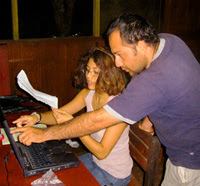I realize that there are people who pay lots of money to go directly where they are going with no other hassle. But then there are people like my father who take what Frequent Flier miles give him, which means switching flights and waiting in a freezing airport for 15 hours while one bag is lost, walking through Iquitos instead of taking a motor car and riding a puttering boat for 12 hours where you are always in someone else’s way. This means you appreciate it so much more when things go right for a change.
Upon arriving at our final destination, Jenaro Herrera, Peru I was struck with a strong sense of déjà vu. Similar to when we would pull in to the Tembé Indian village of Tek-o-how in Brazil, everyone was standing on the bank or dock, waiting and staring. It felt like we were being appraised as we walked up through to town to the waiting truck that would drive us a mile and a half out to the research station operated by the government agency IIAP. Our three-bedroom bungalow was where I took refuge for the next week or two. We ate in Susana’s house, a wonderful cook who served us fruit and egg and cheese sandwiches for breakfast, soup, fresh fish or game meat, fruit juice and massive quantities of rice for lunch, and bread and cheese
 for dinner. It took a little while for my digestive system to adjust and more often than not I wrapped my leftovers in a napkin to feed Bandito, the affectionate but flea ridden resident dog.
for dinner. It took a little while for my digestive system to adjust and more often than not I wrapped my leftovers in a napkin to feed Bandito, the affectionate but flea ridden resident dog.Photo: Sagino (peccary) soup for lunch. © C. Plowden/Center for Amazon Community Ecology
For the first part of our stay I mainly stayed indoors with Gone With the Wind, The Bourne Identity, The Worthing Saga, Snow Falling on Cedars and various other novels that we had either brought with us or had found in the musty library. I made several attempts to go into the forest with Dad, but after the first day, I was suffering from digestive cramps that heat and mosquitoes did nothing to assuage. When the power went on for a hours in the evening, I did help the copal project by entering dat
 a from the day’s field work into the computer and used Photoshop to measure the area of the resin lumps from digital photos taken by Dad and his research assistants.
a from the day’s field work into the computer and used Photoshop to measure the area of the resin lumps from digital photos taken by Dad and his research assistants.Photo: Marissa and Victor entering data. © C. Plowden/CACE
After being reprimanded for not “enhancing my cultural experience,” I went to Susana’s to help prepare lunch. My Spanish was still not very good, merely becoming a little less rusty (having not used the language since the end of school). I struck up a friendship with Diana, Susana’s friend’s 15-year-old daughter and her various other younger helpers. They took me swimming in the large “quebrada” (stream) one day. Later I met a six-year old boy named Miller (pronounced MEE-jer) when Dad was documenting his grandmother in making purses and fans
 from palm fibers. He took great delight in my digital camera and we pieced together a wooden puzzle of vowels and numbers several times in one day.
from palm fibers. He took great delight in my digital camera and we pieced together a wooden puzzle of vowels and numbers several times in one day.Photo: Marissa showing Miller digital photos. © C. Plowden/CACE
The last friend I made was Julio, the nephew of the IIAP station’s director. He was 17, finished with school and worked around the IIAP center at times. I saw him throughout our stay, either in town or around our house. He always smiled and waved to me, which I returned a little hesitantly. I didn’t actually speak to him until a week or so before we left. He loved to listen to Dad and I speak in English. I told him it was a boring language, but he insisted that it was beautiful. He lived with his aunt and uncle and various elderly relatives ever since his mother had left him in Jenaro Herrera at the age of two.
Angel, Victor, and Nestor, Dad’s workers, were all very friendly and I enjoyed talking to them during dinner. One Saturday night we went to the little “discotec” in town, where Angel made me dance. Victor is a fan of my favorite band and generally liked to practice speaking English with me. Nestor was the forest
 guru. He had been doing tree work for the better part of his life and always had some wild anecdote around meal times.
guru. He had been doing tree work for the better part of his life and always had some wild anecdote around meal times.Photo: Nestor and Angel measuring copal tree diameter - woops! © C. Plowden/CACE

No comments:
Post a Comment